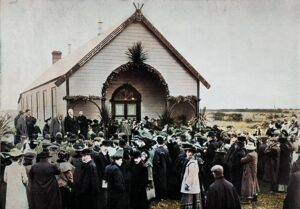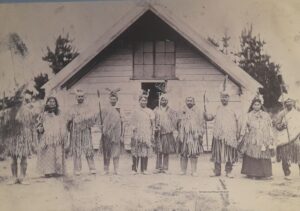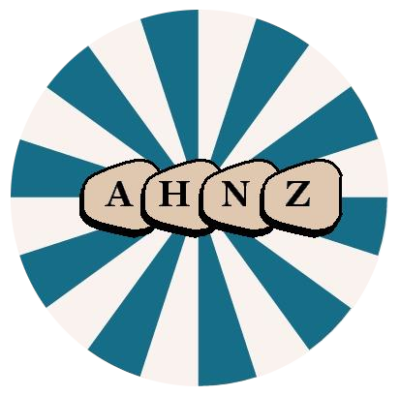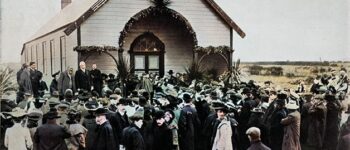1905: Te Hapa o Niu Tireni
June 15, 2025
By AHNZ

Today in New Zealand history, 15 July, 1905, the opening of Te Hapa o Niu Tireni in Temuka, South Canterbury: “Some three years ago the old hall at the Temuka Maori pah, the scene of many a memorable native meeting, was destroyed by fire. Its successor has at last reared its head from the ashes, and was opened yesterday by the Hon. Colonel Pitt, Attorney-General, in the presence of one of the largest gatherings of natives seen in Mid South Island for a long time.” Ref. Press (1905)
It was a new name for an older meeting house (est April 1875.) The name translates to The Broken Promises of New Zealand. Half the cost was met by the owners and The State sponsored the rest just as the previous building had been. An excellent reminder and symbol that The State has an equal interest in promoting and housing the race-based grievance industry.
This 1905 one has since burned down again but replaced by improved buildings (costing millions) by the same name and looking much the same.
“Broken Promises House” is a very reactionary, very Victimhood, thing to self-identify as. It is being passive rather than active in one’s own life. Someone else’s broken promises. They are the actor, you are the acted upon. Indeed, the opening of this new community hall and the visit by the important man, Albert Pitt, was met with much fawning and enthusiasm. It was a bit of a re-play from the previous month, May 1905, when Lord Plunket visited the North Canterbury Maoris at Tuahiwi; A great photo opportunity.
“The natives are nothing if not picturesque, and the gathering yesterday was well worth witnessing. From all parts of South Canterbury, from Banks Peninsula, Christchurch, North Otago, and as far down as the Bluff, had gradually mustered the pah, and yesterday saw a dusky gathering of fully five hundred—laughing wahines, chiefs by proclamation, and young braves—“blood by race.” In all day long the drizzling rain fell, but the laughing Maoris seemed to care not a whit. They pranked themselves out in all their finery, and on the road to the pah, gay-coloured flags and flaming bunting speeded in from damp, while the hall itself was decked with twining wreaths of greenery.” – ibid
“The original Arowhenua wharenui was destroyed by fire in 1903. Its replacement, opened in 1905 and named Te Hapa o Niu Tireni (“The Broken Promises of New Zealand”), held deep significance. The name served as a lasting reminder of the loss of land, resources, and rights experienced by Māori communities across the South Island.” – South Canterbury Museum information panel (viewed 2023)
“Local marae served as meeting points where claims could be discussed and responses considered at hui (meetings). Because of its central location and historical significance, Arowhenua Marae’s meeting house Te Hapa O Niu Tireni (The Error of New Zealand) was a strong focal point for hui and gatherings that focused on Te Keréme.” – ibid
Is it strange as well that ‘Niu Tireni’ was used as the word for ‘New Zealand’? Same in the Treaty of Waitangi text. Almost as if Aotearoa was inauthentic or hadn’t been contrived at that point! Ref. 2003: Michael King’s History of New Zealand, AHNZ
 The so-called grievances of these South Canterbury Maori are rather dubious but of great use to Big Government. It provided a pretense for The State to move land and taxpayer money around. In exchange for this moral cover the natives were able to get a little cut for themselves which otherwise they had no chance of seeing. The story is that Thomas Kemp with his deed had overlooked a fair bargain for these Maoris in 1848. However, it’s far from clear that any of them populated the region at that time anyway. Ref. 1848: The Kemp Deed, AHNZ
The so-called grievances of these South Canterbury Maori are rather dubious but of great use to Big Government. It provided a pretense for The State to move land and taxpayer money around. In exchange for this moral cover the natives were able to get a little cut for themselves which otherwise they had no chance of seeing. The story is that Thomas Kemp with his deed had overlooked a fair bargain for these Maoris in 1848. However, it’s far from clear that any of them populated the region at that time anyway. Ref. 1848: The Kemp Deed, AHNZ
According to panel information at South Canterbury Museum Te Rehe and his sons guided and hosted surveyors and government agents passing through. But, the population statistics we have show that was about it. After all, the area had first been depopulated in the 1820s by a violent civil war and then followed up by a genocidal 1830s invasion from the north. By the 1840s only 3 or 4 people were evident here (Mantell, 1948.) In a more violent and informal population census conducted by Ngati Toa tribesmen in the 1830s the same result was found. Ref. Skinning The Ngāi Tahu Eel From Tail To Head, AHNZ
South Canterbury Museum says “With Temuka township rapidly developing into a significant trading post—and growth occurring in the nearby port town of Timaru—the relocation of the local Huirapa people to the Arowhenua site as a more permanent settlement reflected the need to maintain a stronger visible presence. Māori communities were increasingly becoming isolated from their traditional lands and food-gathering sites.”
The sequence appears to be that these lands were not Maori at all. Rather, they were part of the Colony of New Zealand which created towns like Temuka and Timaru. These drew in Maoris as migrants and then they subsequently were poisoned with resentment by men who knew how to capitalise it for power. The upset activists were probably the second generation migrant based on how these things usually go.
The most famous outburst was in the 1870s led by Hipa Te Maiharoa when his little sect marched far up the Waitaki River near to occupy and settle on land near Omarama. In a similar situation to Parihaka, they were evicted by the State police (Armed Constabulary.)
—
Image ref. Hon. Colonel Pitt addressing the crowd during the opening of Te Hapa o Niu Tireni Marae in 1905 (Reference: Canterbury Museum, 1923.53.365).ngaitahu.iwi.nz. Colour AHNZ (2025)
Image ref. Temuka Maoris at the predecessor meeting house to Te Hapa o Nui Tireni in 1870s. Temuka Courthouse Museum, South Canterbury Museum, AHNZ (2025)
Ref. Press (16 June 1905,) Papers Past
 Like Comment Share
Like Comment Share





